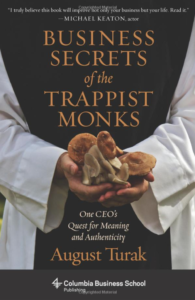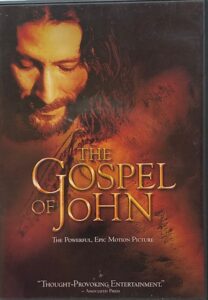In September 2023 we took a trip to Poland. Readers might enjoy this summary of the trip and learnings. Or, they may not, but here it is.
From Chaos to the Church
A Great Course
In January of this year an email from The Great Courses offering big discounts caught my eye. One course offered for only $25, Foundations of Western Civilization, inspired me. History of Western Civilization had been my toughest course as a Vanderbilt freshmen in the fall of 1960, and, while the title was slightly different, foundations vs. history, this looked like a good chance to make up for what I had missed in that course decades ago. I ordered it, and my wife and I enjoyed the 48 episodes, usually one per night, over the next few weeks. I recommend it. Buy and enjoy it (at their discount prices).
An interesting coincidence was that the lecturing professor, Thomas F. X. Noble of Note Dame, had been our son’s History of Western Civ. professor at the University of Virginia almost 40 years ago. Some Goggling of the professor led to “A Noble Farewell: Professor Retires After 41 Years.” In that 2015 article, the professor offered this memory:
“One difference between a public, secular university and a Catholic university, he explained, is that at the latter, “We are actually much freer to talk about things than they are.” He continued, “In public universities, there is kind of a soft left orthodoxy to which everyone must hue, or basically, keep your mouth shut. Whereas here we can actually talk about anything, which is really quite remarkable…it opens our capacity to explores and to investigates and to talk-and even to argue.”
Very interesting, but I believe that “soft left orthodoxy” may have hardened in the last eight years.
I mention this because it is a shame the students of 40 years ago at UVA didn’t get the same emphasis on Church history as we got in the current presentation by Professor Noble. The current version includes an episode titled The Hebrews – Small States and Big Ideas. Here are some phrases from that episode:
“Three central religious ideas contained in the Hebrew Bible constitute the key foundations of Western Civilization…The idea of the covenant…one God for one people, not a god for a place or a state…The idea of exclusive monotheism…The idea of ethical monotheism…and this: “Western literature is unimaginable without its fundamental formative text: the Bible.” I don’t recall getting that view in the Vanderbilt course.
More recently, I have struggled with some of the writings of G.K. Chesterton, a British writer of a century ago who never found an obscure word he didn’t like. But his thinking is profound. For example, he states that we cannot treat the Church as a child once we discover that she is our mother and the mother of our country, “much older and more aboriginal.” That is part of a discussion of confusion of patriotism, nationalism, and faith in God, always a serious current issue.
All these preliminaries are leading to presentation of an updated chart I have worked on over the past several years. It depicts, in simple terms, the first 2000 years of the Church, from God’s selection, preparation, and education of the pagan Hebrew people, through the Incarnation, to the establishment of The Church. Comments and observations are welcome. The chart is discussed in more detail in a post titled The Bible Story.
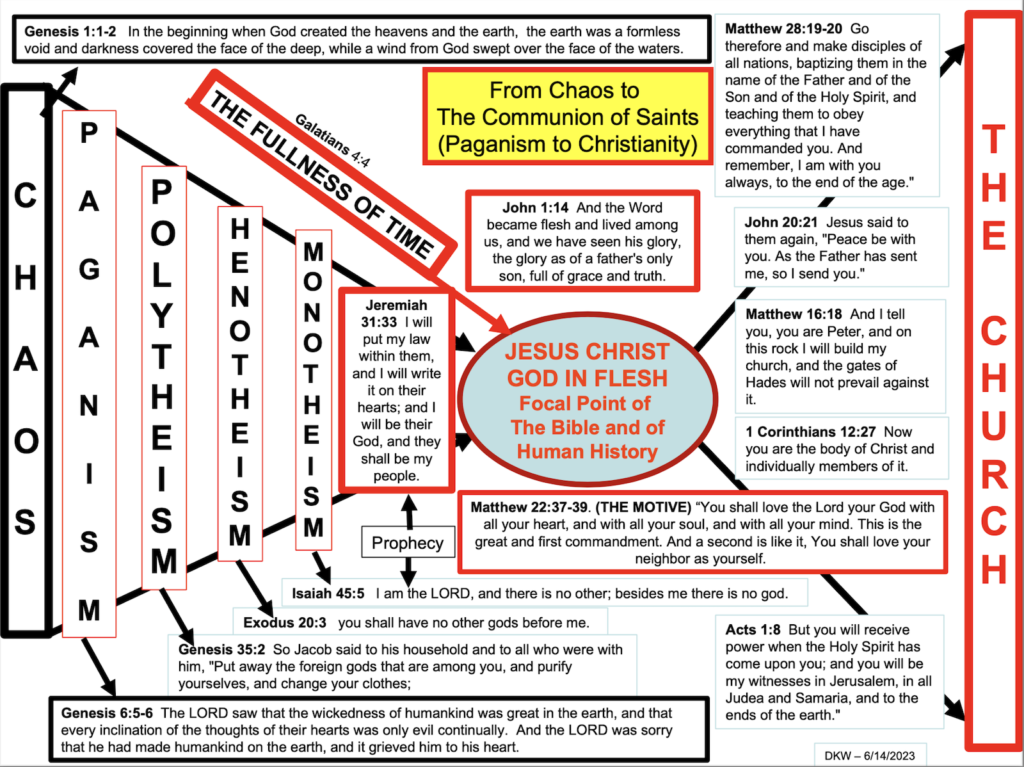
Miracles?
A Chesterton Quote Impossible to Remember

That quote is eight lines out of a 55 line paragraph in Chesterton’s book. Apparently Mr. Chesterton was never at a loss for words. Well, what’s my point?
For about three months, I have been choosing a few lines meaningful to me from Chesterton’s book and copying them into a Google document on my iPad. The goal is to have a better understanding of Chesterton’s interesting defence of orthodox theology which I find to be logical and rational. On the morning of May 14, 2023, the paragraph portion above was what I copied.
Maybe those words about miracles caught my attention because of my current situation, following various advised medical regimens after a diagnosis of pancreatic cancer. The adventure started in the late summer of 2021 with a mild but not painful discomfort in my lower left abdomen. I could have easily continued to ignore it.
However, I got an early October appointment with my GP and after some discussion with him, wondered aloud if we couldn’t just do a scan to see if anything was going on. He said yes and, a couple of hours later, on a Friday afternoon, I was undergoing the scan. A couple of hours after that I got a call from the doctor saying that I would be seeing a surgeon the following week.
The surgeon took a look at the scan and, when I asked if he was going to do a biopsy, said no, that it didn’t matter what it was, it had to go. I guess he knew, from the scan, based on his experience, what it was. The early November surgery he scheduled resulted in removal of about half the pancreas, a few inches of duodenum, the spleen, and a few lymph nodes, two or three indicating malignancy.
After a month or so of surgery recovery, the oncologist started me on a six month chemo regimen. I took the summer of 2022 off, but a scan in early fall dictated a more intense chemo (Folfirinox) for six months. Then in early spring 2023, after a favorable scan, I was shifted to a less intense chemo (5-FU) which is ongoing. As of May 2023, I feel great, pretty much the same as summer of 2021 before the whole adventure started. A few days ago I rode my recumbent bike 20 miles in 75 minutes, a bit faster than four minutes per mile, and about what I was capable of two years ago. I am thankful.
Now, what about the miracle issue? Many people have told me during this ordeal that they are praying for me. I don’t know exactly what they are praying for but I love them and thank them for it. My own prayer for myself has been for fortitude, patience, peace, and joy, all fruits or gifts of the Holy Spirit, throughout the process, wherever it leads. I’m experiencing that now and give thanks for answered prayer, probably not of documentable miracle status.
I am personally attributing miracle status to, and thank God for, the inspiration that sent me to the doctor in October 2021. As I said in an earlier paragraph, the discomfort wasn’t that bad and could have been easily ignored. Without that early detection before lung or liver involvement, I suspect I would be dead or nearly so by this time. Life expectancy for stage 4 pancreatic cancer is 12 to 18 months.
My miracle is not dramatic like such as healing of a crippled man or a man born blind. I don’t believe I would be justified in asking for a miracle of that scale, or that I could ask with faith, and don’t intend to do so.
Of course the skeptic, relying on his or her “doctrine,” would say it was all luck, that I won a small prize at the lottery, or maybe just bad luck that I have the cancer at all, or maybe that the story isn’t over…I’m still going to die from pancreatic cancer. How pessimistic!
I could take full credit for the decision, talking about what a smart fellow I was to see the doctor and suggest a scan when I did. I’m not taking that route. My evidence of a miracle is that I feel good, am still serving and enjoying life, that the whole experience has been sobering, educational, and valuable, and that I am a slightly better person, perhaps better able to express sincere empathy, for having gone through the experience.
Thanks be to God for sending me to the doctor in October 2021. And may He continue to grant me fortitude, patience, peace, and joy throughout the process wherever it leads.
Catholic Teaching on Miracles
I know that my miracle wouldn’t meet miracle criteria established by my Church. Here is an article on the subject.
Bonus
For the curious: Educational Material on Pancreatic Cancer
Massacre of the Innocents
Saturday December 28 on the Catholic Liturgical Calendar is a Feast day in memory of The Holy Innocents, those slain by King Herod in fear of a new King having recently been born, eventually to replace him as King. If only Herod had known that he had less than a year to live!
Much academic analysis of Sacred Scripture of the last century seems aimed at disputation of details, and many scholars have disputed the story of the Massacre of the Innocents found only in Matthew 2. There is no proof of, or absence of, the events reported, but it is refreshing to find some detailed, well referenced, analysis supporting the reasonableness of the Biblical account. I just stumbled on this Paul L. Maier article which has helpful information about 1st Century history and context, an interesting analysis of the mind of Herod, some surprising details, and a surprising ending. Don’t start reading unless you have ten or fifteen minutes to get to the end. The article (which is not Sacred Scripture) is HERE.
Part of the problem in defending these mysterious Bible stories is that we read into them more than is actually written, especially in art. For example, here is an influential 1590 painting depicting the Massacre of the Innocents. Imaginations sometimes run wild, and that seems to be excessive artistic license taken with these simple lines in the Gospel According to St. Matthew. (Matthew 2:16-18)
When Herod realized that he had been outwitted by the Magi, he was furious, and he gave orders to kill all the boys in Bethlehem and its vicinity who were two years old and under, in accordance with the time he had learned from the Magi. Then what was said through the prophet Jeremiah was fulfilled: “A voice is heard in Ramah, weeping and great mourning, Rachel weeping for her children and refusing to be comforted, because they are no more.”
Maier, by the way, is a historian and novelist and a prominent Lutheran leader, writer, and spokesman. You can read about him HERE.
Life in Christ and Getting a Job
Saint Peter Chrysologous was a bishop of the early church, a preacher so skilled in his presentation of the Truth that he is known as the “Doctor of Homilies.” He was born about 350 years after the resurrection of Jesus and lived about 70 years, finally as Bishop of Ravenna, a city in northern Italy and the capital of the Western Roman Empire. His preaching probably drew large crowds in that populous city. Maybe it was a mega-church.
But maybe his crowds were smaller because St. Peter Chrysologous spoke simple and direct Truth about what it means to be transformed rather than conformed to the ways of this world. This morning the Office of Readings in the Liturgy of the Hours included this paragraph from one of his homilies. (This screen shot is from the Universalis APP.)
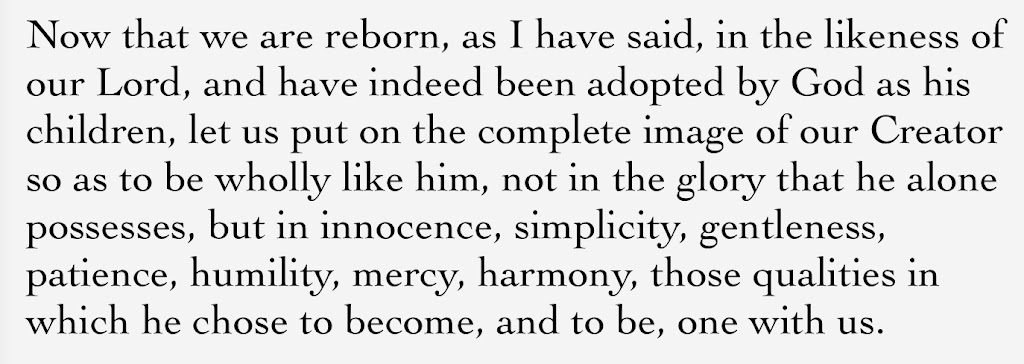
Baptismal Sticking Points
Introduction
When I was received into the Catholic Church in 2011, it was after a few months of weekly meetings in a membership class on Catholic theology and practice, preparation for and reception of the sacrament of reconciliation (confession), and presentation of documentation of my April 15, 1951, baptism at the First Baptist Church, Maryville, TN. I had been eight years old and had “walked the aisle” on March 30, 1951, in response to the traditional Baptist end-of-service invitational hymn, probably on the first or second of the unknown number of verses of “Just as I Am,” and confessed faith in Jesus as my savior and asked to be baptized and received into the church. That simple process is a key element of Baptist “liturgy.”
To be asked to provide that ancient history was a bit surprising to me at the time because I knew that the baptismal practices of Catholics and Baptists were quite different, and that my former Baptist church would have required re-baptism of former Catholics wanting to become Baptist. Here are brief summaries of the key beliefs of the two.
Baptist Baptism
- Only for “believers” who have reached the “age of accountability” and “made a decision” for Christ
- By total immersion in water
- An act of obedience and testimony by the believer
- Symbolizes the death, burial, and resurrection of Jesus and the believer’s death to sin, burial, and resurrection to new life in Christ.
- May be repeated if some new level of commitment or conversion is reached or if the baptized person feels his or her conversion at the initial baptism was not sincere (enough).
Catholic Baptism
- For any who have never been baptized and desire entry into the Church, the Body of Christ, following a period of instruction about the
faith. - For the children, even infants, of Baptized and Confirmed believers who promise, in faith, to instruct and raise those children and infants in the
faith of the Church. Full membership in the Body of Christ requires Christian Education and the Sacrament of Confirmation at an accountable age. - Immersion is fine but not required. Baptism must be by water, with right intent, in the name of the Father, the Son, and the Holy Spirit.
- An act of Grace by the Triune God, Father, Son, and Holy Spirit, through which the baptized are freed from sin and reborn as sons of God.
- Done once only since the effectiveness depends only on the Grace of God and not on the person baptized or the person doing the baptizing. To doubt is an expression of lack of faith. (Baptism done by force, with wrong intent, in some name other than that of the Father, Son, and Holy Spirit, or in lemonade or beer instead of water, is not considered valid. Throughout Sacred Scripture, washing with water is always a symbol of cleaning and removal of sin.)
Reconciling the Two
I have never doubted the validity or sincerity of that innocent and childlike “conversion” and baptism I experienced at age 8 in the Baptist Church, but I have learned that conversion is not a “once and done” thing but a life-long process of learning and serving, examining and confessing, and increasing commitment, a process that I have observed both Baptists and Catholics experiencing.
I remember an insightful statement by a Lutheran seminary professor: “Don’t be concerned about whether you have crossed some imaginary or subjective line. Just focus on making progress in the right direction.”
To oversimplify a bit, I would say that the line to be crossed is key in Baptist theology while Catholic theology focuses more on continually moving in the right direction toward the holiness commanded by Jesus. I suppose that is why Catholics are accused by the “faith alone” adherents of “works righteousness.” Well, anyone familiar with the New Testament will know of lots of uses of such imperatives as study, work, endure, persist, fight, finish, etc. as well as to instances of failure or falling away by believers. And all those “works” can be done in perfect (or even imperfect) faith.
- Baptism is important
- We are saved by grace through faith and it is not from us but is a gift of God. (Ephesians 2:8)
Catholics just see more complications and more divine mystery in the underlying processes and identify even whatever good works we may do as not of ourselves but as gifts of God.
What About Those Other “Denominations?”
And then there are the Orthodox, Episcopal, Lutheran, Methodist, Presbyterian, Church of God, etc. understandings of Baptism. Below are some official statements from church websites. At most of the links there is much more explanation than the simple screen shots I have posted. Since the screen shots are difficult to read, I have typed the words between the names of the denominations and the screen shots. Clicking on the screen shots with make them a bit clearer not not clear enough!
Southern Baptist


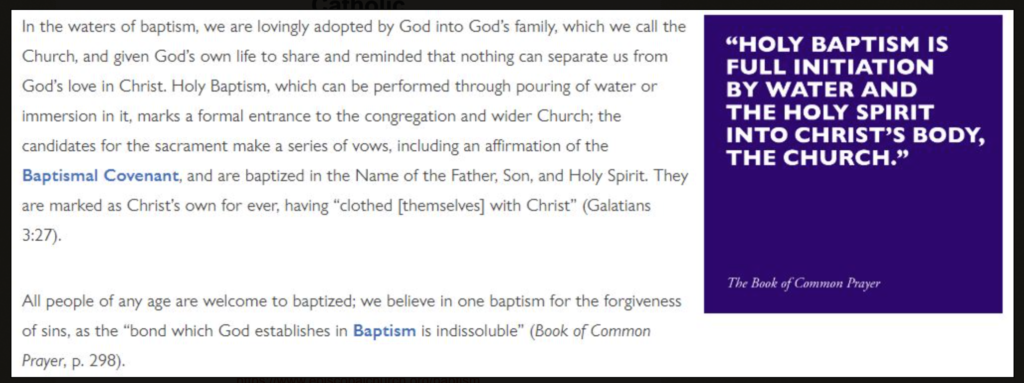
Orthodox

Lutheran (ELCA)

Methodist
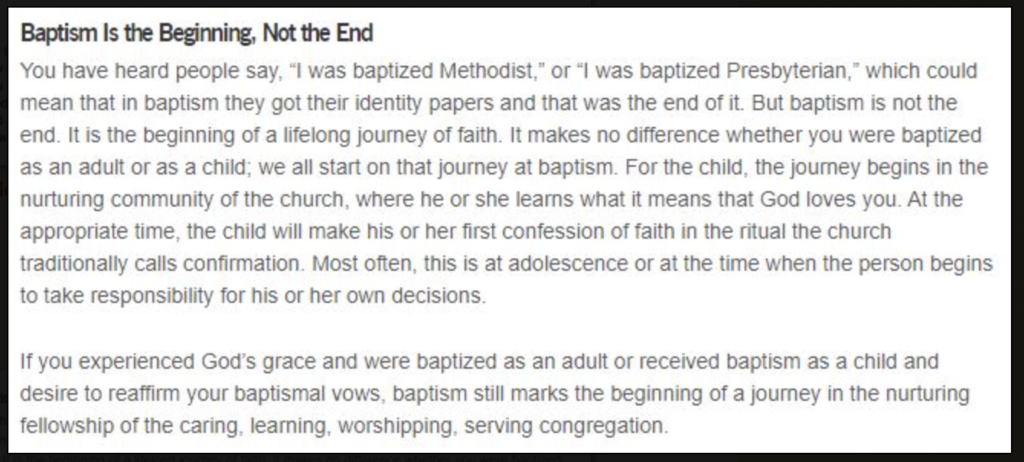

Summary
The Gospel of John Movie (2003)
the silent presence of Mary Magdalene at the Last Supper. I would guess she was not present there, but the Gospel of John certainly considers her a prominent
member of the close followers of Jesus. And, in writings of the first century and earlier, it was not unusual to omit mention of women. The scene at the Wedding at Cana, Mary, Mother of Jesus, instructing the servers to “Do whatever he tells you,” the dialogue with the woman at the well and her resulting evangelization of her community, the interactions with Mary and Martha, and the important role of the women at his resurrection all speak to the importance and prominence of the women followers of Jesus.
Pentecost 2019 – Eight Years Catholic
Introduction
think it was better. I believe there is a lot of truth in the (approximate) words of Flannery O’Conner: “I don’t know what I think until I read what Iwrote.” But, here goes with the current thinking.
Becoming Catholic
Episcopalian, Pentecostal, or whatever Christians who became convinced that the
Catholic Church, with all its warts and wounds and problematic history, really is the Church that Jesus established and left people in charge of when he returned to the Father and is the Church with which they want to be in full communion. They too usually credit the Holy Spirit with motivating their move.
The Question of Authority
Building Christian Unity
me what is going on when he sees a Christian church in the USA on TV and someone is putting his hand on another’s forehead and the latter then falls to the floor unconscious. Well, how does one explain away those difficulties peopleface in believing that the Father sent the Son?
Moving in the Right Direction
years.
Resolving Complicated Issues
should be able to respectfully explain not only why they believe as they do but also why those in other faith traditions believe as they do. None of thebeliefs are without some, sometimes misunderstood or out-of-context, Biblicalfoundation.
The “Full Gospel” Church
any taste.
Common Ground
The Penitential Psalms & Lent
- Psalm 6: Have pity on me Lord, for I am weak (vs. 3)
- Psalm 32: Then I declared my sin to you; my guilt I did not hide (vs. 5)
- Psalm 38: I acknowledge my guilt and grieve over my sin (vs 19)
- Psalm 51: Have mercy on me God, in accord with your merciful love (vs. 3)
- Psalm 102: Lord, hear my prayer; let my cry come to you (vs. 1)
- Psalm 130: But with you (Lord) is forgiveness and so you are revered (vs. 4)
- Psalm 143: Show me the path I should walk, for I entrust my life to you (vs. 8b)
THE Bible Story
Most of us raised in a Christian church know lots of Bible stories. We know about the sins of Adam and Eve, Abraham’s willingness to sacrifice Isaac, the leadership of Moses and Joshua, Samuel’s anointing of Saul and David, David’s killing of Goliath, the wisdom of King Solomon, the birth and ministry of Jesus, the resurrection story, Paul’s Damascus Road story, problems in the early church, etc.
But we may be unable to see the forest for the trees and not have a clear view from the 50,000 foot level of how all those stories comprise THE BIBLE STORY, the theology of the Christian faith, the narrative that begins with the creation stories of Genesis, continues with the choice of a people and promise and arrival of The Messiah, Jesus Christ, and ends with experiences of the early Church, the continuing “Body of Christ.” All that story can rightly be called The Gospel, the good news, focused on Jesus Christ, God in flesh, Savior of the world.
The reason for always keeping THE BIBLE STORY in mind when we read Sacred Scripture is that it keeps us from going off on tangents, from grabbing verses or stories out of that overall context and drawing misleading lessons from them. No matter how deeply we dig, we must always remember the big picture, the context, and make sure our conclusions and positions make sense in that overall context of theological truth.
The chart below is an attempt at visual presentation of THE BIBLE STORY, from the pre-creation chaos, through the revelation of God, to the one holy, catholic, and apostolic church, the continuing Body of Christ, into which we are invited today. Here is not just one verse out of context but thirty one, carefully chosen to illustrate the major parts of that important story.

The right side of the chart covers the incarnation, God in flesh, the ideal King, fully God and fully human, coming and dwelling among us. He heals and teaches and gathers followers, disciples, some of whom become apostles. He teaches prayer, the greatest commandments, the Great Commission, and promises the Holy Spirit. He establishes and teaches the Sacraments. Then he returns to the Father and leaves his Apostles in charge. Under the promised guidance of the Holy Spirit, they build, lead, and guide the early Church, dealing with issues as they arise, under the promised Holy Spirit.


